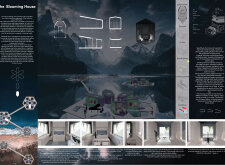5 key facts about this project
At the heart of The Blooming House is a commitment to functionality, providing various living spaces that cater to diverse activities. The modular design allows for a flexible arrangement of areas, including living, dining, sleeping, and study zones, which can be easily reconfigured according to the occupants' needs. This aspect of the project exemplifies a user-centered approach, ensuring that residents can personalize their living environment while maintaining an efficient use of space.
The architectural design employs a thoughtful selection of materials that enhance both the aesthetic and environmental attributes of the house. Predominantly featuring wood for structural elements and external cladding, the design draws on natural textures to blend harmoniously with the surrounding landscape. The use of polyethylene in certain modules allows for buoyant features that can adapt to changing water levels, demonstrating a proactive response to environmental conditions. Large expanses of glass not only invite abundant natural light but also create a seamless interface between the indoor spaces and the exterior views, fostering a sense of openness and tranquility.
The Blooming House embodies a concept of sustainability that extends beyond the physical structure. Renewable energy systems, such as photovoltaic solar panels, are incorporated to minimize the ecological footprint while promoting energy self-sufficiency. This integration of technology into the design elevates the project, showcasing how modern architecture can embrace eco-friendly practices without compromising aesthetic or functional values.
Unique design approaches within The Blooming House manifest through its modular configuration and environmental responsiveness. The innovative use of adaptable furnishings aligns with contemporary lifestyle trends, allowing for multi-functional spaces that can cater to both communal and individual activities. This flexibility not only accommodates changing family dynamics but also promotes a lifestyle that is harmonious with the environment. Furthermore, the psychological benefits of such living arrangements are evident in the project’s focus on natural light and serene surroundings, which contribute to the well-being of its inhabitants.
In summary, The Blooming House is a testament to the evolving nature of residential architecture, where sustainability and adaptability take precedence alongside function and aesthetics. The project invites exploration into its architectural plans, architectural sections, and architectural ideas for those who wish to delve deeper into its design intricacies. Readers are encouraged to review the broader presentation of this project to fully appreciate the thoughtful approaches that define its architecture and enhance living experiences.























